When most people think of termites, they’re likely thinking of Subterranean termites. These termites are regarded as the most destructive of any termite species and are the most widespread by far. But few people know of a specific subterranean species that is highly invasive and remarkably aggressive: the Formosan termite. Worse yet? Formosan termites may be closer to home than you might think.
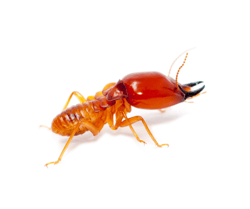 Formosan Termite
Formosan Termite
What are termites?
Termites are an incredibly old (think Late Jurassic period) detritophagous eusocial insect that feast on a variety of decaying plant matter such as wood, leaf litter, and soil humus. Sometimes referred to as “white ants,” termites are soft-bodied and pale in color, appearing very similar to large white ants although only distantly related. They can be found throughout most of the world and are especially prevalent in tropical regions. Unsurprisingly, they are extremely rampant in the United States and can be found in 49 out of the 50, with only Alaska remaining termite-free.
Subterranean Termites
Beginning with the most abundant of all termite species, Subterranean termites are commonplace in every U.S. state with the exception of Alaska. When most homeowners think of termites, they’re probably picturing the Subterranean termite. As their name suggests, these termites live primarily underground in large colonies and feast on any type of wood available to them. They also construct elaborate mud tunnels on the surface, thriving when in contact with moist soil or other water sources.
Drywood Termites
Unlike Subterranean Termites, Drywood Termites don't burrow deep into the moist soil for protection. In fact, they like much less moisture in their environment and food, preferring wood with a moisture content of 12% or less. Due to this, Drywood termites are common in areas with hot and dry climates like the Pacific coast, Central Valley, and the desert of Southern California. These termites enjoy hard and soft woods and live directly inside the wood they consume.
Dampwood Termites
Aptly named, Dampwood Termites flock to wood with high moisture content and live within the wood itself. Because homes are typically constructed with dry wood, Dampwood termites are not very common in most homes. That said, outdoor wooden structures that are exposed to regular moisture such as fences or sheds are prime locations for Dampwood Termites to settle down! Due to their preference for a moist environment, Dampwood termites are most prevalent in the wetter Western or Southern states.
Formosan Termites
Considered a highly invasive species, Formosan Termites originated in China but have since invaded the southern United States. They are larger than most termite species and extremely aggressive in their destruction; a colony of Formosan Termites can consume more than an ounce of wood a day! Because they prefer a milder climate, Formosan Termites have become relatively common in the following U.S. states: Florida, Alabama, Georgia, Louisiana, Mississippi, South Carolina, North Carolina, Tennessee, Virginia, Texas, Arizona, California, and Hawaii.
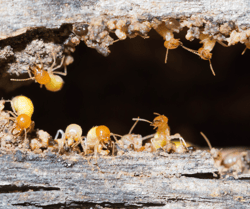 Formosan Termites
Formosan Termites
Do I Need to Worry About Formosan Termites?
If you live in a state where Formosan termites are abundant, you have every reason to be concerned and wary of Formosan termites.
Sometimes referred to as the “super termite,” Formosan termites are known for growing into especially large colonies - we’re talking into the millions! Large colonies are only part of the reason why Formosan termites are an absolute nightmare to homeowners. In addition to congregating in seemingly endless numbers, Formosan termites also have an incredibly voracious appetite. This allows them to create significant damage much more quickly than other native termite species.
Additionally, Formosan termites are adaptive and capable of living in inhospitable conditions. Once a structure is infested, it is extremely difficult to remove the colony and prevent further damage. This is due in part to the Formosan termite’s resistance to common treatment techniques. Remarkably resilient, the Formosan termite can also utilize moisture in a unique way that is very unlike other termite species. Leaky gutters or roofs can be used to create what’s known as cartons, allowing them to retain moisture within their colony above ground. This means their colonies can survive in unlikely places such as plaster and even low-grade metal.
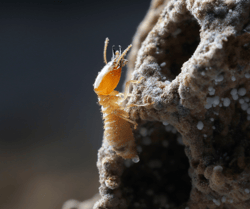 Formosan Termite climbing
Formosan Termite climbing
What kind of damage can Formosan Termites cause?
You now know that Formosan termites are highly destructive and can cause damage quickly - but what does that actually look like? For homes infested by Formosan termites, it can look like:
- Crack-like lines in your home’s walls, foundation, structural beams, and more that are actually Formosan termite tunnels.
- Hollow-sounding structures that were once solid.
- Buckling wood or suddenly squeaky floorboards.
- Bulging ceilings and discolored or drooping drywall.
- Swollen floors and subfloors.
- Damage and discoloration on walls and ceilings that resemble water damage.
- Peeling or bulging paint.
- Mud tubes or tunnels along the foundation of your home.
- Visible mazes in walls or furniture from termites tunneling.
Formosan termites are capable of eating through 300 feet of wood per day. Imagine the kind of damage that can be inflicted by a Formosan colony in your home! If you spot signs of a potential termite infestation in your home, contact a trusted pest professional immediately. Catching an infestation early and before too much damage has been caused is the best way to protect the integrity of your home and avoid shelling out several thousand dollars in repair costs.
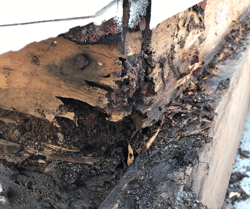 Termite damage
Termite damage
Can I prevent Formosan Termites?
At EcoShield, we believe in putting prevention first! It is much easier (and cheaper!) to prevent Formosan termites from attacking your home than it is to attempt to remove and remediate Formosan termite damage. While certainly easier said than done, there are a few ways that you can help make your home a less easily accessed or hospitable place for termites to hang out. Some prevention tactics include:
- Remove any unnecessary lumber, mulch, wood, or other cellulose-based debris from near the foundation of your home.
- Stack firewood away from the home and ensure the wood is raised off the ground.
- Be mindful of landscaping around the foundation of your home. Wood mulch against your home’s foundation may draw termites near.
- Consider using pine needles or pea gravel in your landscaping.
- Regularly cut and rake any grass near your home.
- Reduce moisture around your home’s foundation by ensuring water from gutters or other drainage is directed away from the home.
- Ensure sprinkler heads are pointed away from the home.
- Utilize vapor blocks to reduce moisture and use dehumidifiers where needed.
- Keep dead trees, rooting wood, and tree stumps away from the home.
- Seal cracks around your home foundation and utilities that may lead to water entry or buildup.
- Turn off outdoor lights at night as they can attract flying termites and swarms.
- Check your roof for signs of water damage, mold, or rot. This is especially important for homes with flat areas of their roof where standing water can accrue.
- Get regular termite inspections from a trusted pest professional.
- Sign up for termite monitoring services from a trusted pest professional.
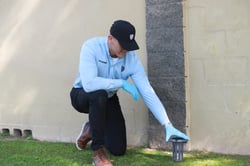 EcoShield technician installing a termite monitor.
EcoShield technician installing a termite monitor.
What should I do if there are signs of Formosan termites in my home?
If you suspect you have Formosan termites in your home, we recommend you call a trusted pest professional like EcoShield immediately. Time is of the essence when dealing with termites, and delays in receiving treatment can result in more damage caused and more money required. With the Termite Shield Program, EcoShield offers year-round protection against termites and identifies potential termite activity before it becomes a headache.
A thorough inspection of your home will allow EcoShield pest technicians to identify problem areas and target them for treatment. EcoShield’s proven termite removal strategy ensures the entire colony is treated through the use of dependable products and with the informed knowledge of a termite’s habits, life cycle, and biology. Termite monitors will be installed every 15 feet to detect termite activity before it becomes catastrophic to your home and wallet.
If you’re experiencing a problem with termites in your home or would like to prevent termite damage in the future, call EcoShield today for a free, no-obligation quote.